During a nine-course meal at a Chinese restaurant in New York City on July 10, Wang Da Sui, design master of China and part of a panel of experts approving the structural scheme for the 632-meter-tall Shanghai Tower, confirmed that the innovative architecture of the twisted and tapering skyscraper—sheathed in sheer glass like a Baccarat crystal—is a guinea pig for crafting China’s first supertall-building code. The code, for structures 300 m and taller with “serious irregularity,” requires performance-based design and extra-stiff frames and puts strict limits on building acceleration. Wang, who also heads the code committee, said the code will be published in about a year “or later.”
Sitting to Wang’s left at the restaurant Jade was the dinner’s host, Dennis C.K. Poon, managing principal for the tower’s structural designer, New York City-based Thornton Tomasetti (TT). Shanghai Tower, on deck to become China’s tallest building, the world’s second-tallest building and the world’s tallest composite structure, “already incorporates some of the spirit of the new code,” said Poon.
Wang, chief engineer with East China Architectural Design & Research Institute Co. Ltd., was in New York City as part of a delegation of six from China. The group also included representatives of the skyscraper’s quasi-governmental owner-developer, the Shanghai Tower Construction & Development Co. Ltd., and the local designer of record, the Architectural Design & Research Institute of Tongji University (Group) Co. Ltd.
The men had flown in the day before from Newfoundland, Canada, where they took part in motion simulations, conducted by project wind engineer RWDI, at the Centre for Marine Simulation on St. John’s. The simulations confirmed the expert panel’s recommendation for a tuned mass damper to increase occupant comfort. “It will be the largest TMD in the world,” said Ge Qing, design director for the owner.
At Jade, between the jellyfish and the lobster, the discussion turned to structural challenges inherent in engineering something never attempted: a record-height steel-and-concrete frame in a seismic zone, founded on “very poor” soft soil and sheathed in a thin glass skin. All agreed the tower’s scale makes the usual issues of differential movement loom larger.
“We had to predict the behavior” of the composite supercolumns, as the concrete shrinks and creeps initially and over time, “without having a large body of knowledge” in the profession and academia on composite structures, said I. Paul Lew, a senior vice president with TT, which is No. 153 on ENR’s Top International Design Firms list. “We will have to monitor the building to see if our assumptions bear out,” he added.
The trip, which included meetings in the offices of TT and design architect Gensler, typifies the intense scrutiny given to the job. The government has had more than 100 expert panels evaluate every facet of design. The Chinese are proceeding extra cautiously, especially concerning structure, life safety and egress, not only because they are crafting a code but because, like the design firms, they have no experience with a 632-m building.
The local and national-level critiques, primarily during design development, complicated the fast-tracked project, which broke ground in December 2008, six months after Gensler won the commission. “We’ve come up with a better project,” but it has involved redesigns, with four or five iterations of the structure alone, says Dan Winey, regional director of San Francisco-based Gensler, which is No. 75 on ENR’s top international list.
TT’s work on the 508-m Taipei 101, in a very active seismic zone and the second tallest skyscraper after the 828-m Burj Khalifa in Dubai, helped convince the experts of TT’s approach in Shanghai, says Poon. Still, to confirm its work, officials had two design institutes do independent performance-based designs.
Different customs, cultures and languages complicate the work, though the U.S.-based designers have Chinese natives in major roles on the job, and offices in Shanghai. “The Chinese style is adversarial and bureaucratic, which makes it difficult to get consensus,” even among the experts, says Christian Von Holten, vice president of the project’s mechanical-electrical-plumbing (MEP) and fire-safety designer, New York City-based Cosentini Consulting Engineers. Cosentini’s parent, Tetra Tech Co., is No. 52 on ENR’s list.
In the U.S., “we go forward like a jet plane; in China, we progress like a bicycle wheel,” says Von Holten.
Gensler, TT and Cosentini are providing drawings through bid documents. The local Architectural Design & Research Institute of Tongji University (Group) Co. Ltd. is stamping drawings.
Sited in Pudong’s Lujiazui Finance and Trade Zone, Shanghai Tower, when completed in 2014, will tower over its tall neighbors—the 492-m Shanghai World Financial Center (SWFC) and the 421-m Jin Mao Tower. The client wanted something iconic, sustainable and “very different” from the “closed” Jin Mao, with its pagoda-like gesture to China’s past, and SWFC, representing China’s present, says Art Gensler, chairman.
The tower had to be buildable by local labor, using easily procured materials and equipment. For MEP, that ruled out, at least conceptually, designing a supertall building, which would need custom-sized equipment, says Douglas C. Mass, Cosentini’s president. Instead, the engineer envisioned a stack of 10 or so smaller buildings, each with its own mechanical services—a series of stacked villages linked by a vertical utility highway.
The idea held. The design by Jun Xia, a Gensler principal, for the 121-story tower calls for nine stacked zones, separated by two-story bands of mechanical and refuge space, and wrapped in glass.
The tower’s overall form can be compared to a shrink-wrapped, ring-toss toy. The toy’s tapered central shaft is the tower’s occupied space between mechanical floors,...












Post a comment to this article
Report Abusive Comment